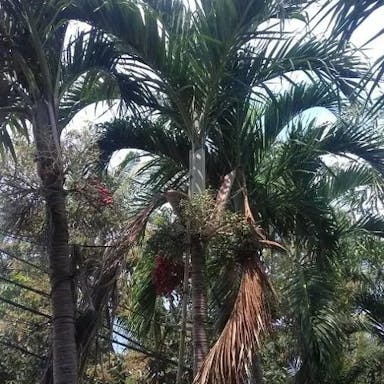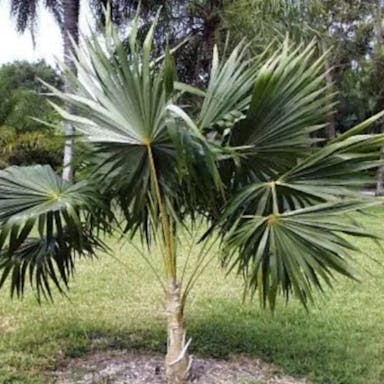Jaggery palm, scientifically known as Caryota urens, is a species of flowering plant in the palm family, Arecaceae. It is native to India, Sri Lanka, and other parts of Southeast Asia. The plant is characterized by its large, pinnate leaves that can reach up to 6 meters in length. The plant produces small, creamy flowers that are arranged in large, drooping clusters. The flowers are followed by small, round fruits that turn orange when ripe. The plant is commonly referred to as the Jaggery palm due to the sweet sap that can be extracted from its trunk and used to make jaggery, a type of unrefined sugar. This species of palm is relatively easy to cultivate in tropical and subtropical climates, requiring well-drained soil and ample sunlight. It is often utilized ornamentally in landscaping due to its striking appearance and fast growth rate.
Jaggery palm
- Scientific name
- Caryota urens
Basic Information
- Arecaceae Family Caryota Genus Jaggery palm Species
- Arecaceae > Caryota > Caryota urens
- 83%
- The Completeness of This Encyclopedia
Please help us complete the encyclopedia, Terrarium is a encyclopedia service to be completed with everyone in the world. Currently, this page is 83% complete. For more information on how to contribute, please click here.
- Palmae
- Tree
- Height
- 120000cm ~
- Flower Color
- Leaf Color
- Anthesis
- Sunlight Exposure
Full Sun Long hours of sunlight from morning to afternoon Partial Shade A location in the shade of a tree or where either the morning or afternoon is shaded Full Shade A place where there is no direct sunlight
- Full Sun
- Hardiness Zones
This is an indicator to know to which zone each plant can winter. Knowing the zone of each plant gives you an idea of the cold temperature resistance when grown in the ground without a roof. 2: -42.7 to -40.0 3: -39.9 to -34.4 4: -34.3 to -28.9 5: -28.8 to -23.3 6: -23.2 to -17.8 7: -17.7 to -12.2 8: -12.1 to -6.7 9: -6.6 to -1.1 10: -1.0 to 4.4 11: 4.5 to 10.0
- 10
- Cold resistance
- Poor
- Heat resistance
- Excellent
- Habitat of origin
- India, Sri Lanka
- Growth Rate
- Fast
What is Jaggery palm (Caryota urens)?
What is Jaggery palm (Caryota urens)
Flower meaning
The flower language commonly used in America for the Jaggery palm is: - Resilience - Strength - Endurance One typical example is \
Calendar of Jaggery palm (Caryota urens)
Calendar
Jaggery palm flowers usually open during late spring and early summer in the USA. The flowers are most attractive in that period. Blooming happens once per year, lasting a few weeks. Full blooming takes around 2-4 weeks generally. Giving the plant enough light, water, and food can make the flowers bloom longer. Removing dead flowers may also help new flowers grow to extend the time of flowering.
How to grow Jaggery palm (Caryota urens)
Watering
For the Jaggery palm, watering often during the time of growth is needed, about once weekly. This desires a well-draining ground mix to stop overwatering, which leads to the roots rotting. At the inactive season, reduce to water once per two or three weeks to act like the natural home. Verify dirt saturation by putting in a finger up to two inches; if dry, time to give water. Water completely, permitting excess to drain from the pot to prevent buildup at the base.
Soil and Fertilizer
Jaggery palm prospers in dirt that drains properly and has a pH measurement of 6.0 to 7.5. It asks for a balanced meal with amounts of 8-3-9 (N-P-K) for best growing. Fertilizer ought to be applied every 2-3 months during the season when it's growing, originating in early springtime and persisting through late summertime. The quantity of plant food applied should depend on the maker's tips, adapted for the dimensions and age of the plant. Natural substances in the earth can also help the plant's expansion, so mixing compost or well-decayed manure into the earth can develop soil value. Regular earth examining can assist determine if any extra nutrients are required for the plant's health and evolution.
Sunlight and Place
The Jaggery palm requires at least 6-8 hours of direct sunlight daily. It prefers temperatures between 65-85°F. During cooler weather, protect it from frost as it is not cold tolerant and may be damaged below 50°F. Place it where it gets the most direct sun. The Jaggery palm thrives with lots of bright sunlight, making it great for sunny spots or as a houseplant.
Advanced Information of Jaggery palm (Caryota urens)
Pruning
Jaggery palm needs regular pruning for health and looks. Pruning removes dead or damaged leaves, helps new growth, and stops overcrowding. Prune Jaggery palm in spring or early summer. First cut back brown or yellow leaves near base. Also trim overgrown or crossing leaves for better air and light. After pruning, clean tools to stop disease spread. Water the plant well to help it recover from pruning.
Planting and Harvest
Jaggery palm is best potted due to its sensitivity to cold temperatures and its ability to thrive in containers. The roots should be spread out when planting in a drainage pot. Water thoroughly after planting. Every few years, transplant the palm into a somewhat larger pot with refreshed soil. Trim any impaired roots while transplanting. Keeping steady moisture is important. Excessive water can lead to root rot. Not enough water can cause dehydration.
Propagation
Jaggery palm can be propagated by seeds, dividing, and offshoots while Palmenvironment places. By coveringsmall separate sections having roots connected. Removing offshoots carefully adult plant replanting proper growing method. Maximizing success, combined methods harvest mature ready propagate.
Pests and Diseases
Jaggery palm is prone to pests. Scale insects weaken the stems. Bud rot can affect new growth. Removing infected plant parts is crucial.
Habitat of Jaggery palm (Caryota urens)
Habitat
Toxicity of Jaggery palm (Caryota urens)
Health Benefits
- edible
- edible
- Toxic
- No toxicity
NO DATA
Toxic for dogs and cats
NO DATA
Q&A of Jaggery palm (Caryota urens)
- What are the unique characteristics and cultural significance of the jaggery palm tree?
The Jaggery Palm, scientifically known as Caryota urens, has bipinnate leaves. It produces a sweet sap used to make palm wine or jaggery sugar. This tree is culturally significant in South and Southeast Asia. Its wood, bark, sap, and leaves are utilized. It symbolizes fertility and prosperity in some cultures.
- Is there a recommended way to choose?
Jaggery palm seedlings have verdant and intact leaves. Roots should be sturdy without decay or insects. Plump intact seeds without damage or mold are ideal. Confirm seeds are not expired. Golden and Silver Jaggery palms exist. Each variety has specific requirements. Selecting a suitable variety for climate and conditions is crucial.












